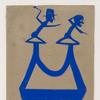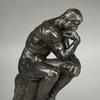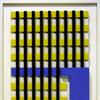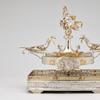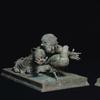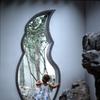Georgia O'Keeffe Retrospective Opens at Tate Modern This Summer
- LONDON, United Kingdom
- /
- March 02, 2016
In July 2016 Tate Modern opens a major retrospective of American modernist painter Georgia O’Keeffe (1887-1986), the first UKexhibition of her work for over twenty years. Marking a century since O’Keeffe’s debut in New York in 1916, this ambitious and wide-ranging survey will reassess the artist’s place in the canon of twentieth-century art and reveal her profound importance. With no works by O’Keeffe in UK public collections, the exhibition will be a once-in-a-generation opportunity for audiences outside of America to view her oeuvre in such depth.
Widely recognised as a founding figure of American modernism, O’Keeffe gained a central position in leading art circles between the 1910s and the 1970s. She was also claimed as an important pioneer by feminist artists of the 1970s. Spanning the six decades in which O’Keeffe was at her most productive and featuring over 100 major works, this exhibition will chart the progression of her practice from her early abstract experiments to her late works, aiming to dispel the clichés that persist about the artist and her painting.
Opening with the moment of her first showings at ‘291’ gallery in New York in 1916 and 1917, the exhibition will feature O’Keeffe’s earliest mature works made while she was working as a teacher in Virginia and Texas. Charcoals such as No. 9 Special 1915 and Early No. 2 1915 will be shown alongside a select group of highly coloured watercolours and oils, such asSunrise 1916 and Blue and Green Music 1919. These works investigate the relationship of form to landscape, music, colour and composition, and reveal O’Keeffe’s developing understanding of synaesthesia.
A room in the exhibition will consider O’Keeffe’s professional and personal relationship with Alfred Stieglitz (1864-1946); photographer, modern art promoter and the artist’s husband. While Stieglitz increased O’Keeffe access to the most current developments in avant-garde art, she employed these influences and opportunities to her own objectives. Her keen intellect and resolute character created a fruitful relationship that was, though sometimes conflictive, one of reciprocal influence and exchange. A selection of photography by Stieglitz will be shown, including portraits and nudes of O’Keeffe as well as key figures from the avant-garde circle of the time, such as Marsden Hartley (1877-1943) and John Marin (1870-1953).
O’Keeffe’s most persistent source of inspiration was nature and the landscape; she painted both figurative works and abstractions drawn from landscape subjects. Black Mesa Landscape, New Mexico / Out of Black Marie’s II 1930 and Red and Yellow Cliffs 1940 chart O’Keeffe’s progressive immersion in New Mexico’s distinctive geography, while works such as Taos Pueblo 1929/34 indicate her complex response to the area and its layered cultures. Stylised paintings of the location she called the ‘Black Place’ will be at the heart of the exhibition.
Still life formed an important investigation within O’Keeffe’s work, most notably her representations and abstractions of flowers. The exhibition will explore how these works reflect the influence she took from modernist photography, such as the play with distortion in Calla Lily in Tall Glass – No. 2 1923 and close cropping in Oriental Poppies 1927. A highlight will be Jimson Weed, White Flower No. 1 1932, one of O’Keeffe’s most iconic flower paintings.
Jimson Weed, White Flower No. 1 1932 is an important example of the artist’s investigations into still life, and particularly the flowers for which she is most famous.
The painting of a humble garden weed is being loaned to Tate Modern from Crystal Bridges Museum of American Art in Arkansas. This will be the first time the work is displayed outside the US since being acquired by the Museum in 2014. It is the most expensive painting sold at auction by a female artist.
The Jimson weed bloom is native to New Mexico and the focus O’Keeffe affords it in the painting reflects her growing affinity with the region in the 1930s - an association that would continue throughout her lifetime. Being fond of this particular plant, she allowed Jimson weed to flourish around her patio at her home in Abiquiu and made it the subject of multiple works, each time presenting a new viewpoint. The frontal perspective on the flower in Jimson Weed, White Flower No.1 1932 and the symmetry this gives the composition, makes it a particularly striking work in the series.
The painting reveals the profound influence O’Keeffe took from modernist photography – its concern with the study of form, use of close up or magnification and cropping - a practice that was influenced by her professional and personal relationship with husband and photographer Alfred Stieglitz (1865-1946), as well as her close friendships with a number of other photographers.
Achim Borchardt-Hume, Director of Exhibitionsat Tate Modern, said: “We are delighted to be showing this iconic work by O’Keeffe for the first time in the UK for over twenty years and would like to give thanks to Crystal Bridges Museum for making this possible. The exhibition offers a rare opportunity for European audiences to view O’Keeffe’s work in such depth and what better moment to celebrate her influential career than 100 years after her debut andcoinciding with the opening of the new Tate Modern.”
Georgia O’Keeffe opens at Tate Modern on 6 July 2016, curated by Tanya Barson, Curator, Tate Modern with Hannah Johnston, Assistant Curator, Tate Modern. The exhibition is organised by Tate Modern in collaboration with Bank Austria Kunstforum, Vienna and the Art Gallery of Ontario, Toronto.


